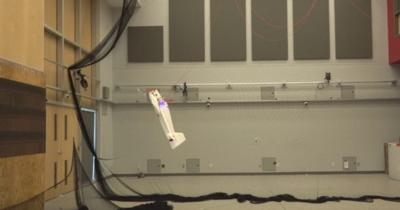Thu, Sep 07, 2017
Uses Microspines To Attach To Rough Surfaces
One of the big advantages to multi-rotor drones is their ability to take off and land vertically. But even a small landing spot might not always be available if needed. Enter the Multimodal Autonomous Drone (S-MAD) developed by researchers at the University of Sherbrooke in Canada.

S-MAD is a fixed-wing drone with the ability to land on a vertical surface like a wall or tree and stay there. To develop the technique, engineers studied how birds take off and land and installed similar mechanisms on the aircraft. They have achieved a 100 percent success rate for landing on vertical surfaces, according to a report appearing on Engadget.
According to an excerpt from the abstract of a scholarly paper on the Createk Design Lab YouTube site, the company says the S-MAD "uses a thrust-assisted pitch-up maneuver to slow down rapidly before touchdown. Microspines are used to cling to rough walls, while strictly onboard sensing is used for control. The effect of thrust on the suspension’s landing envelope is analyzed and a simple vertical velocity controller is proposed to create smooth and robust descents towards a wall. Multiple landings are performed over a range of flight conditions."
In its YouTube video, Createk says the aircraft could have applications such as monitoring areas hit by earthquakes, as well as the inspection of buildings, bridges and other infrastructure.
To land, the aircraft uses sensors to detect the wall, and then executes a rapid pitch-up maneuver to present the microspines to the landing surface. Power is added on final approach to maintain vertical speed and pitch angle. The company says over 30,000 simulations were run to perfect the technique.
To take off, the S-MAD develops enough power to hang from its prop while the microspine feet disengage, and then return the aircraft to a horizontal flight profile.
Createk and the university are continuing to refine the aircraft, and no commercial launch has been discussed.
(Image from YouTube video)
More News
Aero Linx: Model Aeronautical Association of Australia MAAA clubs are about fun flying, camaraderie and community. For over 75 years, the MAAA has been Australia’s largest fl>[...]
Touchdown Zone Lighting Two rows of transverse light bars located symmetrically about the runway centerline normally at 100 foot intervals. The basic system extends 3,000 feet alon>[...]
“Discovery and innovation are central to our mission at Virgin Galactic. We’re excited to build on our successful record of facilitating scientific experiments in subor>[...]
How To Get A Story On Aero-TV News/Feature Programming How do I submit a story idea or lead to Aero-TV? If you would like to submit a story idea or lead, please contact Jim Campbel>[...]
Student Pilot Reported That During Rotation, “All Of A Sudden The Back Of The Plane Kicked To The Right..." Analysis: The student pilot reported that during rotation, “>[...]
 ANN's Daily Aero-Linx (05.02.24)
ANN's Daily Aero-Linx (05.02.24) ANN's Daily Aero-Term (05.02.24): Touchdown Zone Lighting
ANN's Daily Aero-Term (05.02.24): Touchdown Zone Lighting Aero-News: Quote of the Day (05.02.24)
Aero-News: Quote of the Day (05.02.24) ANN FAQ: Contributing To Aero-TV
ANN FAQ: Contributing To Aero-TV NTSB Final Report: Cirrus Design Corp SR20
NTSB Final Report: Cirrus Design Corp SR20



